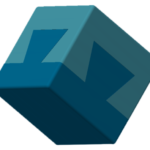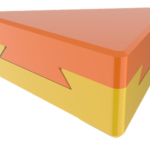
Technichal Specifications
How to use this exercise?
Carpentry
Using the model in class to facilitate an open-minded approach in design. The insight the students get from the model can be used in prototypes for their designs.
Number of pieces of this exercise
6
General description
The model assembled pieces is composed of two parts that were printed out separately. In this exercise there will be three types introduced. All types show a repeating pattern, which, once assembled, seems to create an inseparable joinery. These models are grounded on the well-known lock and key concept and the clearance between the two parts should allow for the parts to slide in a smooth way.
1. Dovetail: This model’s basic geometry is a cube and it is made up of two halves. One half has two protrusions which are formed like the classic dovetail in carpentry (but distorted). The other half has two cavities which are formed like the dovetail too. These two halves create a connection, that can only be loosened by pushing the two parts in the right directions. There is only one possible axis that allows movement (forwards and backward, hence two directions). This axis is in parallel to the axis along which the cavities and the protrusions are oriented and constructed.
2. Pentagon: This model is a variation on the Dovetail. Here the two halves show a pentagonal form, and apart from that it follows the same construction principles as the Dovetail.
3. Triangular Dovetail: The two halves form an equilateral triangular that can only be loosened by rotating the triangle and then pulling the parts apart. Here the pattern is rotated around the z-axis and intersected with the triangular body.
Additional Material
Models used:
License Info
Attribution 4.0 International (CC BY 4.0) https://creativecommons.org/licenses/by/4.0/You are free to:
Share — copy and redistribute the material in any medium or format
Adapt — remix, transform, and build upon the material
for any purpose, even commercially.
Under the following terms:
Attribution — You must give appropriate credit, provide a link to the license, and indicate if changes were made. You may do so in any reasonable manner, but not in any way that suggests the licensor endorses you or your use.
No additional restrictions — You may not apply legal terms or technological measures that legally restrict others from doing anything the license permits.
Learning Specifications
How can the model be used in class?
The model could first be demonstrated without anticipating the solution. The students could then propose their ideas on the making process and construction of the connection. Afterwards the students could explore the model by themselves.
Moreover, the model could be used to demonstrate its practical use in design. Students could explore designs with prototypes that can be assembled by using the principles of the assembled pieces model.
What benefits can its use have?
Students should be able to understand the geometric principles that make this connection possible. An open-minded approach in design should be facilitated. Eventually they should be able to design their own distinct models.
Furthermore, students can use the principle of the connection to check their design on a smaller scale by designing their prototypes by applying this kind of easy assembly. Here, the students could explore the differences and potentials of both traditional manufacturing techniques and additive manufacturing technologies.
Can it be used in other subjects?
These geometries could be used in diverse design subjects where a directional unlocking function is desired (i.e. furniture joints). By combining them correctly interlocking is possible as well.
Topics: Carpentry, Design, Engineering, Geometry


